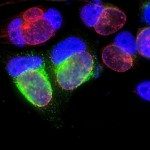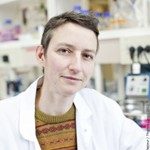Link to Pubmed [PMID] – 15265988
J. Cell. Sci. 2004 Aug;117(Pt 17):3923-33
In epithelial cells, endocytic activity is mostly dedicated to nutrient and macromolecule uptake. To invade these cells, Chlamydiaceae, like other pathogens, have evolved strategies that utilise the existing endocytic machineries and signalling pathways, but little is known about the host cell molecules involved. In this report, we show that within five minutes of infection of HeLa cells by Chlamydia caviae GPIC strain several events take place in the immediate vicinity of invasive bacteria: GM1-containing microdomains cluster, tyrosine-phosphorylated proteins accumulate, and intense actin polymerization occurs. We show that actin polymerization is controlled by the small GTPases Cdc42 and Rac, which become activated upon infection. Expression of dominant negative forms of these GTPases inhibits C. caviae entry and leads to abnormal actin polymerization. In contrast, the small GTPase Rho does not seem essential for bacterial entry. Finally, phosphatidylinositol 3-kinase activity is also required for internalization of C. caviae, probably downstream of the other molecular events reported here. We present the first scheme of the events occurring at the sites of invasion of epithelial cells by a member of the Chlamydiaceae family.


